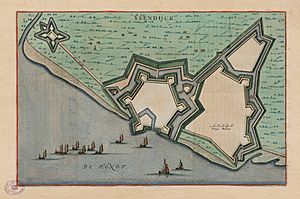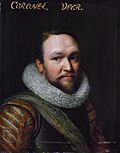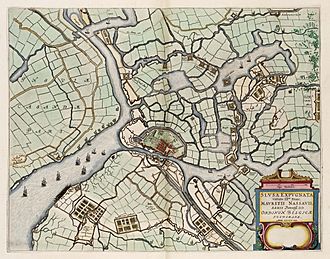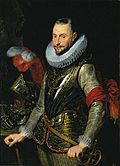Siege of Sluis (1604) facts for kids
Quick facts for kids Siege of Sluis (1604) |
|||||||||
|---|---|---|---|---|---|---|---|---|---|
| Part of the Eighty Years' War and the Anglo–Spanish War | |||||||||
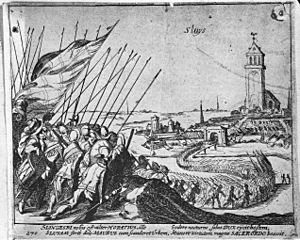 The capture of Sluis by the Dutch and English army in 1604 from the Atlas Van Loon |
|||||||||
|
|||||||||
| Belligerents | |||||||||
| Commanders and leaders | |||||||||
| Strength | |||||||||
| 11,000 | 15,000 4,200 (Sluis) |
||||||||
| Casualties and losses | |||||||||
| 800 casualties, sick or dead to disease | 2,000 casualties, sick or dead to disease 5,800 captured 10 galleys 15 assorted ships 1,400 slaves released |
||||||||
The Siege of Sluis in 1604 was an important military event. It happened during the Eighty Years' War and the Anglo–Spanish War. From May 19 to August 19, 1604, Dutch and English forces fought to capture the town of Sluis.
An army led by Prince Maurice of Orange (Dutch) and Horace Vere (English) crossed the Scheldt River. They took control of areas like Cadzand, Aardenburg, and IJzendijke in the Spanish Netherlands. This led to the main battle: the siege of Sluis, which was held by the Spanish.
The Spanish city of Ostend had been under siege for three years. Maurice's army hoped to help Ostend. Even though Ostend eventually fell to the Spanish, Sluis was captured. This was a big victory after tough fighting. The Dutch and English even defeated a Spanish relief force.
Contents
Why Sluis Was Important
In 1600, the Dutch and English armies used the city of Ostend as a base. They wanted to invade Flanders. After winning the Battle of Nieuwpoort, they tried to capture Dunkirk. Dunkirk was a port where privateers (pirates working for a government) attacked English and Dutch ships.
However, the Dutch leaders disagreed on what to do next. They decided to focus on taking Spanish areas in the Netherlands instead. Maurice agreed, and his forces left Ostend. This left Ostend open to Spanish attack.
Leaders in The Hague, the Dutch capital, needed a strong place to control. They wanted a backup if Ostend fell. At first, they thought about capturing Maastricht. But this city wasn't very helpful for protecting merchants and fishing boats.
Johan van Oldenbarnevelt, an important Dutch statesman, knew something important. Queen Elizabeth I of England had died the year before. The new English king, James I, was talking to Spain about peace. Oldenbarnevelt worried that peace might mean the Dutch coastal towns held by England would be lost. These towns were given to the Dutch in 1585 as part of the Treaty of Nonsuch.
So, Oldenbarnevelt turned his attention to the Cadzand area. This area was south of the Western Scheldt River. A new port could be used there. The chosen place was the inland port of Sluis.
Sluis was very important to the Dutch. It protected the region of Zeeland to the north. It also offered a base for future attacks. Controlling Sluis would help them secure the Scheldt River. This river led to the important port city of Antwerp. It also gave them control of the Zwin waterway, which led to Bruges.
The Spanish, led by the Duke of Parma, had captured Sluis from the Dutch and English in 1587. After a Dutch-English victory over a Spanish fleet in 1602, the Dutch navy blockaded Sluis. When the remaining Spanish ships tried to leave Sluis in 1603, they were defeated. Their commander was killed.
With Spanish ships trapped, Sluis was quickly reinforced. The Spanish wanted to protect it from attack. They made sure Sluis was very well fortified. The town had a large group of 4,500 Spanish and Italian soldiers. Don Mateo Serrano commanded them. There were also 1,400 galley slaves, mostly Turks. Many warships, including ten war galleys, were in the town. Hundreds of civilians also stayed.
The Campaign Begins
On April 18, 1604, Maurice gathered his army at Dordrecht. They boarded ships at Arnemuiden and Flushing. The combined Dutch and English army had 11,000 soldiers. Maurice's younger brother, Frederick Henry, was second in command. Sir Francis Vere was recovering from war wounds.
Maurice's cousins, Counts Ernest Casimir, Louis Gunther, and William of Nassau-Siegen, led the Dutch troops. The English group had almost 4,000 soldiers and 600 cavalry. Horace Vere, Francis's brother, was in charge of the English. Other English officers included John Ogle, Edward Harwood, and Edward Cecil for the cavalry.
A huge number of ships were gathered. The Dutch and English army crossed the Scheldt River. On April 24, they successfully landed on the other side, between Vulpen and Cadzand.
Taking Cadzand
In the next two days, Hofstede and all other forts on Cadzand island surrendered to Maurice's army. On April 30, they crossed to Coxie. They captured the forts there, including the largest one, St. Catharine's. Ambrogio Spinola, the Spanish commander, saw the threat. He blocked the path to Ostend.
Capturing IJzendijke
The Dutch and English army then moved to IJzendijke. This was a strong, fortified town. It was three leagues east of Sluis. It had mostly Italian soldiers. The army surrounded it by May 6.
Before the siege could fully begin, 2,000 Spanish troops came by boat from Sluis. They wanted to surprise the Dutch and English. Six hundred of them landed and broke through the Dutch defenses. But a few English and Scottish companies held their ground. They fought hard and pushed the Spanish back to their boats. Many Spanish boats sank, and the rest retreated.
Maurice continued the siege of IJzendijke. He sent his trumpeter to ask the soldiers to surrender. But a musket shot hit the trumpeter in the head, killing him instantly. Maurice was very angry about this. He ordered his trenches to be dug closer to the town. The next day, the 600 soldiers in the town surrendered. They handed over the musketeer who had killed the trumpeter.
Taking Aardenburg
After leaving a small group of soldiers in IJzendijke, the army marched again. Two days later, they arrived at the Spanish-held town of Aardenburg. This was another large, fortified town. It was four miles south of Sluis. It had 500 soldiers. When the army arrived, the Spanish saw they were outnumbered. They had no choice but to surrender.
Capturing Aardenburg was very important. It gave the Dutch and English access to two parallel streams. These streams were navigable to Sluis. This made it a key position for surrounding Sluis. Soon after, Dutch cavalry searched the area, reaching the walls of Ghent and Bruges.
Battle of the Oostberg Line
Maurice wanted to take all military posts nearby before starting the main siege of Sluis. To do this, he needed to stop Spanish forces from helping the Sluis soldiers. Don Luis de Velasco, a Spanish general, had placed his 2,000 men in a narrow pass. This pass was in front of Damme, a town between Sluis and Bruges. This position was called the Oostberg Line.
On May 17, after leaving soldiers in IJzendijke and Aardenburg, the Anglo-Dutch force moved against the Spanish. Count Ernest led the first group, with cavalry under Marcellus Bacx. But they were caught off guard, and Spanish resistance was strong. The Dutch suddenly fell back to a spot where Velasco found the stream could be crossed at low tide.
Sir Horace Vere saw that the Spanish were gaining ground. He acted quickly. He chose 100 pikemen and 200 musketeers from his brother's regiment. He put them under the command of Sir Charles Fairfax. A second group of 400 men, led by Sir John Ogle, followed. Two hundred of Cecil's cavalry came to help. The path was narrow, with swamps and flooded lands on both sides.
Fairfax led his men to attack with great energy. After a sharp fight, he forced the Spanish to retreat behind their defenses. He followed them closely, and they were defeated. Many Spanish soldiers fell into the swamps and flooded lands. Some escaped, but others drowned or got trapped. More of Ogle's men joined the fight to complete the defeat.
The Spanish under Velasco were driven away. They suffered heavy losses. Four hundred twenty-three were killed, wounded, or drowned. Another 400 were taken prisoner. Maurice gave the credit for this hard-fought battle to the English companies. He praised Horace Vere.
Maurice's entire army crossed the stream while fighting continued upstream. The Spanish, fearing they would be cut off, quickly scattered to Damme.
The Siege of Sluis Begins
By May 23, Maurice's army controlled the streams completely. The Spanish fort of St. Joris, with 300 men and nine guns, was now alone. It soon surrendered. This meant Sluis could be properly besieged.
Colonel Van der Node, who had been governor of Ostend, crossed the Zwin at low tide. He had thirty companies, including ten English ones. They fortified a spot chosen by Maurice, across from Sluis. This controlled the path from Bruges and Damme. The town was now completely surrounded.
By the end of May, the Archduke (a Spanish leader) ordered Spinola to help Sluis. This was more important than the siege of Ostend. Spinola agreed, though he was unhappy. He sent 4,000 men with supplies for the trapped soldiers. But this force was defeated. All the wagons of supplies were captured in a series of planned ambushes.
The besiegers built strong trenches and square forts. These protected them from attacks from the town and from outside. Maurice set up his camp on the north side. Count Ernest was on the other side of the Zwin. Count William was on the east. Colonel Van der Node and Horace Vere were in the flooded lands with many armed boats.
By the end of June, it was clear that taking Sluis was more important than helping Ostend. Ostend was mostly ruins and no longer valuable to the Dutch. Sluis, however, was mostly intact. It was a good replacement for them.
In July, Spinola tried again to help Sluis. The Archduke ordered him to, saying Spain could not lose another Flemish port. On July 28, Spinola camped between Bruges and Damme. He had 10,000 men and 600 wagons of supplies. He then moved towards Van der Node's area, passing Ardenburg. His goal was to reach the town using a wide road that was still open.
Maurice saw the plan. He put a large force to work. In 48 hours, they dug a trench across the road. This stopped Spinola's passage. Maurice then placed several guns between Van der Node's and Count William's positions. They fired heavily and continuously on Spinola's camp.
Inside Sluis, hunger and sickness affected both civilians and soldiers. But news of the Spanish relief force gave them some hope.
On the evening of August 6, Spinola attacked Count William's position. There was a fierce fight in the trenches. Finally, the Spanish were forced to retreat. A Dutch group surprised the attackers from the side. The Spanish lost about 700 men.
On August 18, after two months of trying to help Sluis, Spinola gave up. He marched away, discouraged. He returned to continue the siege of Ostend.
The soldiers in Sluis were now very hungry. The 4,000 half-starved soldiers could not fight any longer. Many could barely walk. On August 20, 1604, Governor Serrano heard that Spinola and Velasco had retreated. He had no choice but to surrender the city to Maurice.
The Spanish soldiers were allowed to leave with military honors. The same terms were given to the people living in the town. The 4,000 Spanish soldiers, many of them sick, marched out with drums playing and flags flying. Sixty of them died from exhaustion as they tried to march. Besides these troops, there were almost 1,400 starving galley slaves, mostly Turks.
What Happened After
The next day, Maurice took control of Sluis. He gave the official leadership of the town to his brother, Frederick Henry, Prince of Orange. A huge amount of goods was captured. This included ten galleys that the Spanish had failed to sink. Fifteen merchant ships with most of their goods were also taken. In addition, a large store of weapons, 84 brass guns, and 24 iron guns were captured.
The Dutch and English soldiers stayed in Sluis. They strengthened the town in case the Spanish tried to attack again. The Dutch and English had light losses. Sir John Ogle lost an eye during the Oostberg battle. Many suffered from disease. Count Louis of Nassau died of fever a few days after the surrender.
News of Sluis's capture was celebrated in England. In London, ships at St Katharine Docks fired salutes to honor the victory.
The Turkish galley slaves who had marched out were sent back to the Barbary coast by the Dutch. No ransom was asked for them. Because of this good deed, the Dutch signed a trade treaty with the Bey of Algiers.
On September 22, Daniel de Hartaing surrendered Ostend. Maurice had ordered this, and The Hague had agreed. The city was just a pile of ruins. The Spanish entered Ostend after a three-year siege. The soldiers there, fewer than 3,000, were allowed to keep their weapons and armor. On both sides, tens of thousands of people were killed or got sick. The town was completely destroyed.
Spain wanted to take back their only military port in the western North Sea from the Dutch. But the capture of Sluis and Cadzand by Maurice's army balanced this out. Sluis became a new base for Dutch naval operations. With Sluis gone, Spain lost a good harbor for their galleys. It was also a convenient place for an invasion of the United Provinces, which could have stopped Dutch trade.
South of Sluis, new defenses were built. Access to the Zwin was blocked. Town walls were strengthened, along with forts on both sides of the front. Around Damme, seven-star-shaped forts were built. These served as a strong defense against Bruges.
This was almost the last major battle of the Anglo-Spanish war before Ostend surrendered. England officially ended its involvement. However, a clever part of the Treaty of London allowed the Dutch to still hire English and Scottish soldiers. These soldiers would be paid by the Dutch as volunteers.
The Spanish tried to recapture Sluis in 1606. In a night raid, attackers managed to get inside. But half-dressed English soldiers fought them off. The English seized money, valuables, weapons, and equipment from the Spanish soldiers they caught and killed.
Sluis and its nearby towns stayed in Dutch hands for the rest of the war. They are still part of the Netherlands today. Some people say Sluis is the most Flemish town in the Netherlands.
Key People in the Campaign
Myles Standish, who later became a military advisor for the Plymouth Colony and sailed on the Mayflower, fought in this campaign.
See also
 In Spanish: Asedio de La Esclusa (1604) para niños
In Spanish: Asedio de La Esclusa (1604) para niños



